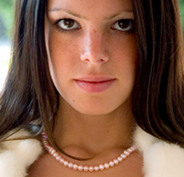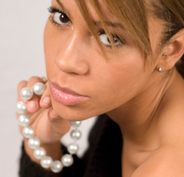|
|
|
|
Pearl Glossary |
|
|
|
 |
|
|
|
|
|
Shoppers often
have questions regarding the type of pearls we sell and the quality
of our pearls. To better inform the shopper we have written this
guide detailing the different types of pearls in the marketplace
today as well as tips on caring for pearls and different pearl lengths. |
|
|
Q. What are
cultured pearls? |
|
|
A. To
simply put it, cultured pearls are natural pearls, but with a little
help from man. In nature pearls are formed when a foreign object,
such as a parasite or piece of sand lodges itself in the oyster’s
soft inner body where it cannot be expelled. With cultured pearls,
highly skilled technicians open the live pearl oysters carefully,
then surgically implant a small polished shell bead and a piece of
mantle tissue in the oyster. |
|
|
In an effort
to ease this irritant, the oyster’s body takes defensive action.
The oyster begins to secrete a smooth, hard crystalline substance
around the irritant in order to protect itself. This substance is
called nacre. |
|
|
As long as the
irritant remains within its body, the oyster will continue to secrete
nacre around the irritant, layer upon layer. After a few years, the
irritant will be totally encased by the silky crystalline coatings.
The result — the lovely and lustrous gem called a pearl. |
|
|
Q. What are
the different types of pearls? |
|
|
A. Freshwater:
This is primarily the type of pearl we sell. Freshwater cultured
pearls come from freshwater mussels produced in China, Japan, and the
United States. They have greatly improved in quality over the last
decade and provide the best value for the consumer. Peacock pearls
are a type of freshwater cultured pearl. They refer to the freshwater
black pearls with hues of blues, grays, purples, greens and silver. |
|
|
Tahitian:
Tahitian cultured pearls are grown in a variety of large pearl
oysters found primarily in French Polynesia. Their beautiful, unique
colors (which can range from light gray to black, and green to
purple) and large size can command very high prices. |
|
|
Akoya:
Akoya pearls are the classic cultured pearls of Japan and are also
known as saltwater cultured pearls. They are the most lustrous of all
pearls found anywhere in the world. In recent years, China has been
successful in producing Akoya pearls within their own waters.
However, Akoya pearls are still the most difficult to grow. |
|
|
South Sea:
White South Sea cultured pearls are grown in large tropical or
semi-tropical oysters in Australia, Myanmar, Indonesia and other
Pacific countries. They generally range in size from 10mm to 20mm and
command premium prices because of their relative rarity and large size. |
|
|
|
|
|
|
|
|
|
|
 |
|
|
|
|
Q. What are
the different pearl necklace lengths? |
|
|
A. Choker:
14" to 16" in length. A pearl choker is perhaps the
most classic and yet versatile of all the single strand lengths. A
simple pearl choker can go with virtually any outfit from casual to
fancy eveningwear, and just about any neckline imaginable. |
|
|
Princess:
17" to 19" in length. The princess length necklace is best
suited for crew and high necklines. It also complements low plunging necklines. |
|
|
Matinee:
20" to 24" in length. Longer than the choker, and just a
bit shorter than an opera length, the matinee necklace is the right
choice for casual or business dressing. |
|
|
Opera:
28" to 34" in length. The opera necklace is the queen of
all the lengths. When worn as a single strand, it is refined and
perfect for high or crew necklines. When doubled upon itself, it
serves as a versatile two-strand choker. |
|
|
Rope:
over 45" in length. |
|
|
Q: WHAT
LENGTH OF PEARL NECKLACE DO WOMEN PREFER? |
|
|
A: The
24" strand is good for business suits. The 32" strand can
be worn straight or doubled up. The 18" necklace is also good
because it is an all-purpose length that works well with jeans as
well as an evening dress. Triple strand pearls compliment Chanel
style suits and a nice finishing touch to most evening wear. |
|
|
Princess:
At 17-19 inches, the princess-length pearl necklace makes a perfect
chain for a pendant or pearl enhancer. It looks great with crew neck
tops, and works beautifully for both high necklines and daringly low ones. |
|
|
Matinee:
This mid-length pearl necklace, at 20-24 inches, is great with a
business suit or a dress. It's not as formal as an opera-length
strand or as short as a choker, but is still perfect on its own. |
|
|
Opera:
Perfect for a night at the opera or any other dress-up occasion, the
opera pearl strand is 28-34 inches in length. As a single strand, it
looks wonderful with high or crew necklines, but you can also double
it on itself and turn it into a highly versatile, shorter length. |
|
|
Rope:
At over 45 inches long, the rope pearl is very luxurious--and highly
sexy! You can have clasps along the length to help you break it down
into shorter necklace and bracelet combinations but, on its own, it's breathtaking. |
|
|
|
|
|
|
Frequently
Asked Q's |
|
|
|
|
|
 |
|
|
|
|
|
|
|
Q. How do I
care for my pearl jewelry? |
|
|
Don't toss
them carelessly into a purse or jewel box where they can become
scratched by hard metal edges or harder stones. Don't expose them to
acid-based hair sprays, cosmetics, or perfumes. Don't clean them with
chemicals or abrasives. Treat pearls gently. Place them in a chamois
bag or wrap them in tissue when putting them away. Put on pearls
after applying cosmetics, hair sprays and perfume. Wash your pearls
with mild soap and water after taking them off. This will remove all
traces of perfume, cosmetics or hair spray from the pearls. If you
wear your pearl jewelry once a week or more take them to a jeweler
for restringing once a year. Cosmetics and ordinary wear can weaken
and stretch the nylon threads on which the pearls are strung. |
|
|
Q: I WANT A
FINE QUALITY PEARL NECKLACE. WHAT IS MOST IMPORTANT? |
|
|
A: The
luster is the reflectivity of a pearl and it's a function of the
fineness and regularity of the layers deposited around the nucleus.
It makes the pearl more attractive and flattering. Color is also very
important, but it varies by demand. In the United States the white
rose color is preferred; in Europe ivory is preferred; and in Japan
the preference is silvery white. |
|
|
Q: HOW
OFTEN SHOULD I HAVE MY PEARLS RE-STRUNG? |
|
|
A:
Pearls should be re-strung once a year if the person wears them
against the skin. If they are worn often, 6 months is not
unreasonable. You should re-string when pearls become loose and
spacing is visible. If pearls become loose, the string will enlarge
the hole and the pearls won't be straight anymore. Pearls should be
strung on silk, not nylon. |
|
|
Q: WHAT
COLOR IS MOST POPULAR FOR PEARLS? |
|
|
A:
Americans generally prefer rose but women should select pearls
according to their own skin color. Rose' generally looks best on fair
skin. Cream colored pearls look best on olive skin. Black and silver
colored pearls complement most skin colors. |
|
|
Q: ARE
CULTURED PEARLS REAL PEARLS? |
|
|
A:
Cultured pearls are real pearls that are formed naturally by a
mollusk with assistance from man. A shell bead is inserted into the
mollusk to act as a seed. The mollusks are then put back in the water
and watched carefully on the farm. Non-nucleated pearls are extremely
rare and expensive. Keshi pearls and freshwater pearls are a great
alternative for those who want all natural pearls. |
|
|
|
|
|